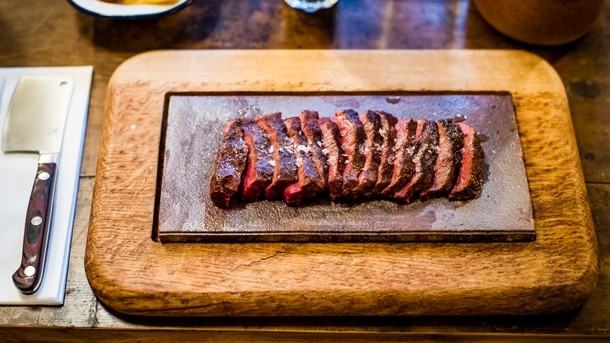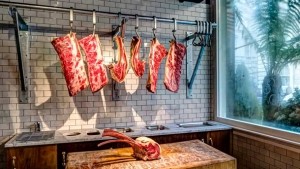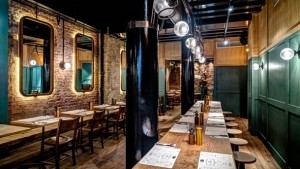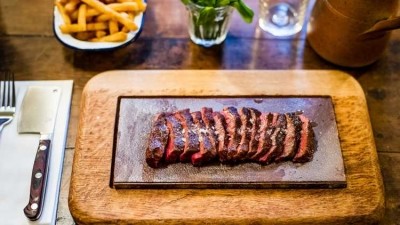Business Profile: Flat Iron

For a man who has recently opened a new restaurant, Charlie Carroll comes across as being pretty laid back. For someone who also has a five-month-old baby at home, he is remarkably so.
The founder of the now four-strong Flat Iron restaurant group had recently taken a two-week holiday but, given the timing, he might well have had other things on his mind. In fact, he returned to work on the day the new 75-seat Flat Iron in Shoreditch, the newest restaurant in the group, was handed over, only one week before opening.
That he was able to go away at such a critical time says a lot, not only about Carroll’s confidence in his fledgling affordable steak restaurant group, but also of his management style and approach to business. “We opened Beak Street (Flat Iron’s first permanent site) in November 2012, and in April 2013 I went and spent some time in America,” he recalls. “I had the view from the outset that the sites were going to have to be able to operate independently of me from very early on.”
It’s an approach that might have proved unworkable once the restaurant became a reality, but Carroll has so far been able to do this thanks to the very simple blueprint he has created for his group. While many steakhouses serve a huge variety of cuts as well as many starters and sides, requiring a lot of kitchen space, staff and skill, Flat Iron is an altogether more simple operation. The restaurant primarily serves just one cut of meat, the eponymous flat iron which, at £10 (it comes served with a green salad) is significantly cheaper than those at many of the capital’s grander steakhouses. Other cuts and dishes, such as rump cap and the popular burger and béarnaise sauce, are available as specials and there’s a choice of creamed spinach, market greens, a blue cheese salad, roast aubergine and dripping cooked chips as sides, but that’s about it.
There are no reservations, the wine list comprises just five reds and five whites and the dessert option begins and ends with a salted caramel sundae ice cream.
Gruelling experience
A food obsessive and determined from a young age that one day he would run his own business, Carroll studied natural sciences at Cambridge, specialising in biology. However, his career path beyond that gave him the drive and, more importantly, the acumen to set up and operate his steak restaurant group as he does.
While at university, Carroll did a few unpaid shifts in the kitchens at The Fat Duck and restaurant Gordon Ramsay, the latter of which he recalls as being a particularly gruelling experience. It put him off the whole restaurant career idea for a few years and convinced him that when he did pursue it again, it would not be from the bottom up. Instead he took a graduate job at Parthenon-eY strategy consultancy. The hours were long and the work exacting, although it gave him invaluable experience in the industry he is now in, including running the slide rule over Carluccio’s for a potential buyer.
While immersed in the restaurant world, Carroll started formulating an idea for a restaurant of his own based around a quality, affordable steak offer and decided he needed a grounding in how the sector operates.
A meeting with Mark Selby, co-founder of Wahaca, led to a job as operations adviser at the Mexican restaurant group, where his analytical skills were put to use to help the chain’s expansion. It also gave him an opportunity to effectively trial a start-up when he was given free rein to launch a takeaway outlet from a van, initially serving the Canary Wharf area.
“It was a project in miniature. It gave me the chance to come up with the offer and think about every aspect of how it would operate, all with someone else’s money and loads of support,” he says.
Carroll then toyed with the idea of getting some general manager experience before launching on his own, but discussions with Selby and also Tom Byng, founder of the Byron burger brand, encouraged him to ‘crack on’ with his idea.
What followed was nine months of working on his business plan and of addressing one of the biggest challenges – how to source very good steak that could be sold at an affordable price and that would give the right GP. Preferring secondary cuts of meat from prime cows to premium cuts of meat from secondary animals, Carroll made it his mission to be able to consistently source the former, gaining some degree of expertise in butchery, farming and cooking methods in the process – he is now the owner of a 50-strong herd of Dexter cattle in Yorkshire, from which he produced a World Steak Challenge gold medal-winning steak.
The flat iron cut, as it is called in the US (it is also known as a butlers’ steak and oyster blade), taken from the shoulder of the animal, turned out to be the most effective way of achieving his aims and formed the basis of the brand.
Herding cats
Sourcing wasn’t the only hurdle Carroll had to clear in order to make Flat Iron a reality; funding was another significant piece of the jigsaw puzzle. Crowdfunding was yet to gain traction and Carroll says it was a time before restaurateurs realised how good the enterprise Investment Scheme really was. Instead, he took the decision to try the concept out as a pop-up, launching Flat Iron above the Owl and Pussycat pub in Shoreditch in July 2012. Within two weeks, he had people queuing for 90 minutes to eat his steaks, which he had spent the day butchering himself.
The early buzz around Flat Iron gave him the credibility needed with landlords and investors, many of whom had their interest piqued by the prospect of a mono dish menu, £16 (net of VAT and service) spend per head, steak concept.
The following month he signed on the most serendipitous nil-premium, kitchen-fitted site in Soho’s Beak Street – it started life as a 60-seat restaurant with a basement bar, but has since been given over to a further 30 seats – even though he hadn’t finalised his funding. He equates trying to pin down interested investors to “herding cats”, but with his site secure, by October he had seven ‘angels’ (who are still involved, but no fresh equity has been raised since Beak Street), who provided the necessary £400,000 to get the first permanent restaurant open.
Flat Iron proved itself quickly, turning tables sometimes more than six times a day, yet Carroll was still surprised that NatWest was willing to show faith in him so early on in the company’s story. “Frankly, I was slightly amazed that they came on board,” he says. “I wasn’t expecting to have any debt funding for the first two or even three sites, but we were able to do 50:50 cash flow/debt for our second site, and NatWest has supported me ever since.”
Setting the sites
Getting funding for Flat Iron’s second site on Denmark Street, also in Soho, might have been straightforward, but finding it was far from easy. While Carroll says that three out of the four restaurants he has opened have practically fallen into his lap, site number two was the exception. He recalls having seen around 50 sites before he walked in as the second viewer in Denmark Street. Within 15 minutes he had shaken hands with the vendor, who agreed to take it off the market. It is now a 65-seat Flat Iron.
Flat Iron’s third site, by contrast, in Covent Garden, finally saw the brand make the move from 60 to 90-cover restaurants into a site more akin to that of a steakhouse. Opened at the back end of last year, the site on Henrietta Street is the group’s largest and most expensive venue to date, with 180 covers, an in-house butchery, ice cream kiosk and downstairs bar, developed in collaboration with brewery Copper Dragon, that is home to 14 glass-fronted oak barrels of Yorkshire beer.
Carroll is actively seeking more sites now and is hopeful of opening another restaurant this year. While he is confident of doing more next year too, he is not giving away any details. london is the focus for now, but he has had approaches regarding a site in Brighton, which he thinks would be a particularly easy transition for the brand.
Flat Iron could work anywhere in the UK, he believes, but that is not necessarily his immediate aim. “People who have opinions I respect have said it could be a 100 to 200-site chain, and I think it could be,” he says. “With about £16 per head spend and serving something as mass appeal as steak, there are very few places it couldn’t go. But do I want that? Probably not imminently. Am I conscious of expanding too quickly? Definitely.”
Carroll’s consultancy work has given him a strong commercial and analytical outlook and Flat Iron has the systems and processes in place to make growth as painless as possible. Capex required is relatively low and the sites have a utilitarian, stripped-back look rather than a more opulent finish, with Carroll working with his design and creative partner Ben Chapman, owner of Soho-based Thai barbecue restaurant Smoking Goat.
All the sites have their differences, and not just in their look. Group bookings and cocktails are more of a thing at Covent Garden, while Shoreditch has an open ember spit roast oven that is a feature of the restaurant. Due to its less central location, Carroll has visions of Shoreditch becoming an all-day operation with free Wi-Fi and good value coffee for morning workers that he hopes will build atmosphere and drive lunch trade. each site also does its own specials, which make up about 15 per cent of sales.
Like many operators that have come up through the pop-up route, Flat Iron still has a cult following. And so far, Carroll has resisted the temptation to tinker with the formula. The website is simple and non-interactive, almost antagonistically so in that it only lists the four restaurant locations (no phone numbers) and its social media pages. Save for the addition of new locations when they open, Flat Iron’s web presence hasn’t changed since the restaurant’s early days.
It’s a simple strategy that has so far worked, with Carroll successfully having given steaks the casual-dining treatment with a company that turns over £8m a year. With customers likely to be keeping a close eye on their wallets in this post-Brexit world and opting for places that offer value for money, it is likely that it will be his five-month-old baby, and not any worries about the future, that will be keeping him awake at night.





























